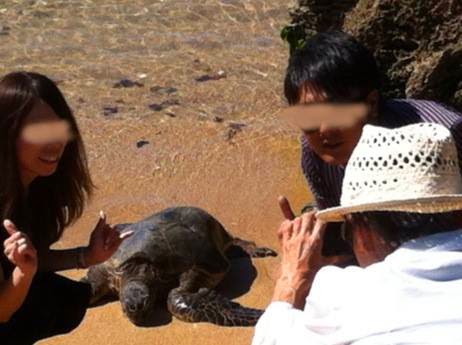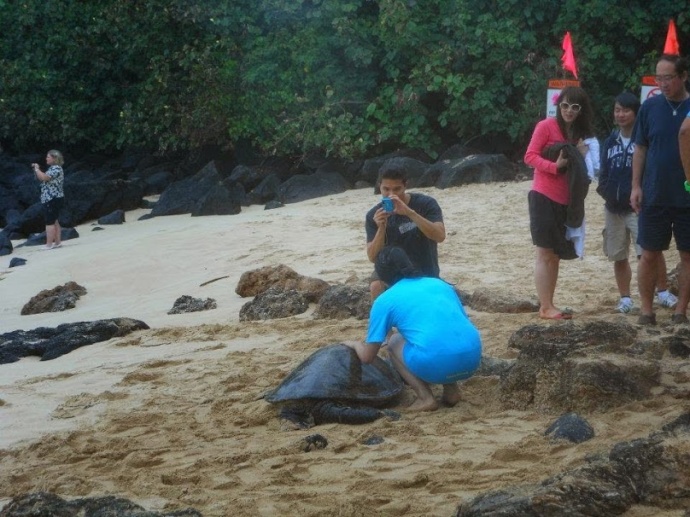Public Reminded of Laws Protecting Hawaiʻi Sea Turtles

These photos illustrate DLNR’s concern with people getting too close to green sea turtles (honu) at Ali‘i Beach.
By Wendy Osher
The Department of Land and Natural Resources is reminding the public to respect Hawaii’s sea turtles by viewing the protected animals responsibly.
The two types of sea turtles most frequently observed in nearshore waters are the green sea turtle (honu), which is listed as a threatened species; and hawksbill (‘ea) sea turtle, which is listed as endangered under the Endangered Species Act.
“Although federal and state wildlife conservation laws differ in some respects, all prohibit actions that can harm, injure, kill, or otherwise disturb sea turtles without a permit,” said DLNR officials.
That means that feeding or touching turtles in any way is considered a disturbance and is therefore considered illegal. DLNR advises the public to keep a 6- to 10-foot buffer as a best practice for sea turtle viewing.
The public is also advised to not touch, pick up, restrain, jump over, straddle, pursue, ride, harass, harm, or otherwise disturb the animals, noting that federal and state consequences apply.

These photos illustrate DLNR’s concern with people getting too close to green sea turtles (honu) at Ali‘i Beach.
“We ask for people’s help to ensure turtles are not disturbed, which is especially a concern at high-visitor use beaches,” said DLNR Chairperson William J. Aila, Jr. “We want to remind the community that all sea turtles are protected, and that both state and federal consequences apply to anyone harming green sea turtles.”
State officials say areas of concern include Laniakea and Ali‘i beaches on the North Shore of O‘ahu, as well as locations across Maui, Kaua‘i, and the Big Island of Hawai‘i.
“In the water, turtles may appear friendly or curious; however, for your safety and theirs, please view them from a distance, act responsibly, and never feed turtles. A turtle that associates people with food can act aggressively and may bite,” Aila said in a department press release.
To report suspected violations, the public can call the DLNR Division of Conservation and Resources Enforcement at (808) 587-0077 or 643-DLNR.
Earlier this year, wildlife officials reminded the public to be mindful of Hawksbill and green sea turtles as they begin their 2014 nesting season along Maui beaches. The public is advised to stay at least 30 feet away from nesting turtles and watch quietly, as they are easily disturbed.
Turtle hatchlings should not be picked up and placed in the ocean, as “they need to crawl on their own to set their navigational compass and increase their chance of survival,” wildlife service officials said.











